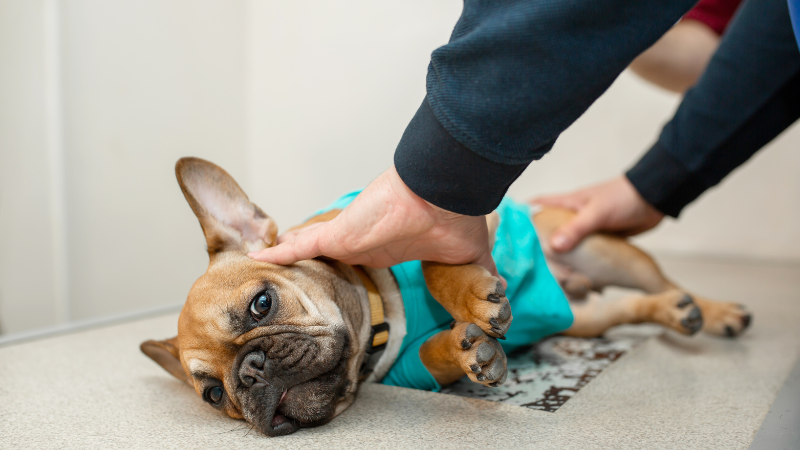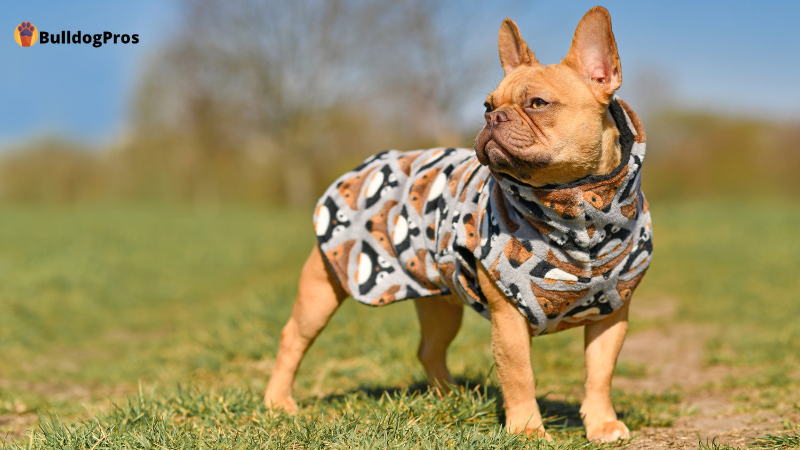As a French Bulldog owner, it’s important to be aware of the potential health issues that your furry friend may face. One of the most common health problems in French Bulldogs is intervertebral disc disease (IVDD). In this post, we’ll look closer at IVDD in French Bulldogs, including its causes, symptoms, diagnosis, treatment options, and prevention measures.
What is IVDD?
Intervertebral disc disease, or IVDD, is a condition that affects the spinal cord in dogs. The intervertebral discs that separate the vertebrae in the spine can bulge or rupture, causing spinal cord compression. This can lead to a variety of neurological symptoms and mobility issues and can lead to severe pain, weakness, and even paralysis in some cases. IVDD is more common in certain breeds of dogs, including French Bulldogs.
Risk Factors Of IVDD
While the exact cause of IVDD in French Bulldogs is unknown, several risk factors can increase the likelihood of the condition. These risk factors include:
- Genetics: Frenchies are more prone to IVDD due to their genetic makeup and breed history.
- Age: IVDD is more common in older French Bulldogs, although it can occur in dogs of any age.
- Weight: Overweight French Bulldogs are at a higher risk of developing IVDD due to the added pressure on their spine.
- Trauma: Trauma to the spine, such as a fall or accident, can increase the risk of IVDD.
Video: Understanding IVDD in French Bulldogs
Signs and Symptoms of IVDD in French Bulldogs
The signs and symptoms of IVDD in French Bulldogs can vary depending on the severity and location of the disc disease. Some common signs to look out for include:
- Difficulty walking or standing.
- Hunched back or arched spine.
- Pain or discomfort when touched or picked up.
- Weakness in the hind legs.
- Inability to control bladder or bowel movements.
If you notice any of these symptoms in your Frenchie, it’s important to seek veterinary care immediately. Early detection and treatment can lead to a better outcome for your furry friend.
Diagnosing IVDD in French Bulldogs

If your French Bulldog shows signs of IVDD, your veterinarian will perform a physical exam and diagnostic tests to confirm the diagnosis. These tests may include:
- X-rays: To look for any abnormalities in the spine or vertebrae
- CT scans or MRI (magnetic resonance imaging): To get a more detailed view of the spinal cord and discs
- Myelogram: A dye is injected into the spinal fluid to make the discs more visible on X-rays
Treatment Options for IVDD in French Bulldogs
The treatment for intervertebral disc disease (IVDD) in French Bulldogs will depend on the severity of the condition. Mild cases of IVDD can often be treated with conservative methods, such as rest, medication, and physical therapy. More severe cases may require surgical intervention.
Conservative Treatment Options
- Rest: Restricting activity and movement can help reduce pressure on the spine and allow time for healing.
- Medication: Pain relievers and anti-inflammatory medications can help manage pain and reduce inflammation in the spine.
- Physical Therapy: Exercises and rehabilitation can help strengthen the muscles around the spine and improve mobility.
Surgical Treatment Options
Surgical treatment may include hemilaminectomy, ventral slot surgery, or dorsal laminectomy. The treatment plan will depend on the severity of the condition and the individual needs of the dog.
Hemilaminectomy:
During a hemilaminectomy, a portion of the affected vertebrae is removed to relieve pressure on the spinal cord. However, unlike ventral slot surgery, which involves accessing the spine from the front (ventral) of the neck, a hemilaminectomy involves accessing the spine from the back (dorsal) of the dog’s body.
As with any surgical procedure, there are risks associated with a hemilaminectomy. These can include bleeding, infection, and damage to surrounding tissues. However, when performed by a skilled and experienced veterinary surgeon, hemilaminectomy can be a highly effective treatment for dogs with severe IVDD.
Ventral Slot Surgery:
The procedure involves making a small incision in the dog’s neck and removing a portion of the affected vertebrae to relieve pressure on the spinal cord. This can help to reduce pain, improve mobility, and prevent further damage to the spinal cord.
While ventral slot surgery can be highly effective for treating IVDD, it is a complex procedure that should only be performed by a skilled and experienced veterinary surgeon. There are also some risks associated with the surgery, including infection, bleeding, and damage to surrounding tissues.
Dorsal Laminectomy:
This is similar to a hemilaminectomy in that it involves removing a portion of the vertebral bone to relieve pressure on the spinal cord. However, with a dorsal laminectomy, a larger portion of the lamina is removed, which provides greater access to the spinal cord.
During a dorsal laminectomy, the dog is placed under general anesthesia, and an incision is made along the midline of the back over the affected area of the spine. The surgeon then removes a portion of the lamina, which is the bony arch that covers the spinal cord. This allows the surgeon to access the disc and remove any herniated or damaged material that is compressing the spinal cord.
Because a dorsal laminectomy involves more extensive removal of bone than a hemilaminectomy, it can be a more invasive procedure with a longer recovery time. However, it can also be a highly effective treatment for dogs with severe IVDD that have not responded to other treatments.
As with any surgical procedure, there are risks associated with a dorsal laminectomy, including bleeding, infection, and damage to surrounding tissues.
Disc Fenestration:
Disc fenestration involves making a small incision in the outer layer of the disc, which allows the inner material to protrude outward and relieve pressure on the spinal cord.
During a disc fenestration, the dog is placed under general anesthesia, and a small incision is made over the affected area of the spine. The surgeon then carefully cuts through the outer layer of the intervertebral disc, allowing the inner material to protrude outward. This reduces pressure on the spinal cord and can relieve symptoms of IVDD.
Disc fenestration is considered a less invasive procedure than other surgical options for IVDD, such as laminectomies. Because the outer layer of the disc is not completely removed, there is less risk of damage to the surrounding tissues and nerves. Recovery time is typically shorter for disc fenestration than for other procedures as well.
However, disc fenestration is not always the best choice for every dog with IVDD. It may be less effective for dogs with more advanced or severe cases of the condition.
As with any surgical procedure, there are risks associated with disc fenestration, including bleeding, infection, and nerve damage.
Post-Surgical Care and Recovery for French Bulldogs with IVDD

If your French Bulldog has undergone surgery for IVDD, they will require proper post-surgical care and recovery to ensure they heal properly. Your veterinarian will provide specific instructions, but here are some general guidelines to keep in mind:
1. Keep your Frenchie confined to a small area to prevent them from jumping or running around too much.
2. Limit activity for the first few weeks after surgery and gradually increase exercise as recommended by your veterinarian.
3. Monitor your Frenchie’s incision site for any signs of infection, such as redness, swelling, or discharge.
4. Administer any prescribed medication on schedule, including pain medication, antibiotics, and anti-inflammatory medications.
5. Attend any follow-up appointments as scheduled, and report any concerning symptoms or changes in your Frenchie’s behavior to your veterinarian.
Long-Term Management Strategies for French Bulldogs with IVDD
After your Frenchie has recovered from surgery, it’s important to implement long-term management strategies to prevent future episodes of IVDD. Here are some tips to keep your Frenchie healthy:
Maintain a healthy weight: Obesity is a risk factor for IVDD, so make sure your Frenchie is at a healthy weight to reduce the strain on their spine.
Regular exercise: Regular, low-impact exercise can help keep your Frenchie’s muscles and joints healthy and reduce the risk of IVDD.
Proper diet: Feeding your Frenchie a balanced diet with plenty of vitamins and minerals can help keep their bones and joints healthy.
Keep your Frenchie’s spine aligned: Avoid activities that put stress on your Frenchie’s spine, such as jumping or climbing stairs. Use ramps to help your Frenchie access elevated surfaces.
Massage and physical therapy: Gentle massage and physical therapy can help improve circulation and muscle tone in your Frenchie’s back and hind legs.
By following these long-term management strategies, you can help prevent future episodes of IVDD and keep your Frenchie healthy and happy.
Preventing IVDD in French Bulldogs
You may be wondering how to prevent IVDD in French bulldogs. Unfortunately, IVDD cannot be prevented entirely. However, there are steps that you can take to reduce the risk of it occurring in your French Bulldog. One of the most important things you can do is to maintain a healthy weight for your dog. Excess weight puts added stress on the spine and can increase the risk of disc problems. Regular exercise can also help keep your dog’s spine and muscles strong.
Another important step is providing your French Bulldog with a healthy diet with plenty of vitamins and minerals. A diet rich in omega-3 fatty acids can also help keep the spinal cord healthy.
FAQs
If you have more questions about IVDD in French Bulldogs, here are some commonly asked questions and their answers:
What are the symptoms of IVDD in French Bulldogs?
The symptoms of IVDD in French Bulldogs can vary but may include a reluctance to move or jump, dragging of the hind legs, back pain, and loss of bladder or bowel control.
If you notice any of these symptoms in your French Bulldog, it is important to seek veterinary care immediately.
Can IVDD in French Bulldogs be cured?
There is no cure for IVDD in French Bulldogs. However, with prompt veterinary care and proper treatment, it can be managed effectively, and your dog can still lead a happy, healthy life. Treatment options may include rest, medication, and surgery.
Are there any alternative treatments for IVDD in French Bulldogs?
Alternative treatments for IVDD in French Bulldogs include acupuncture, chiropractic care, and physical therapy. These therapies can help reduce pain, inflammation, and muscle spasms associated with IVDD.
However, it’s important to note that alternative treatments should only be used under the guidance of a qualified veterinarian and should not replace traditional medical care.
We hope that these FAQs have been helpful in addressing some of your questions about IVDD in Frenchies. If you have any further questions, don’t hesitate to consult with your veterinarian.
Additional Reading
Conclusion
IVDD is a serious condition that can cause severe pain and mobility problems for French Bulldogs. It is important to be aware of the signs and symptoms of IVDD and seek veterinary care if you suspect your dog may be affected.
While IVDD cannot be prevented entirely, taking steps to maintain your dog’s health can help reduce the risk of this condition.
Remember, if you suspect your French Bulldog may have IVDD, it’s essential to seek veterinary care immediately. Early intervention can improve your Frenchie’s chances of recovery and prevent further damage to their spine.
For more helpful guides and product reviews related to owning a French Bulldog, be sure to check out the rest of our blog at bulldogpros.com.
Resources
Thank you for reading IVDD in French Bulldogs. Do you have any experience with IVDD? Please comment below.



